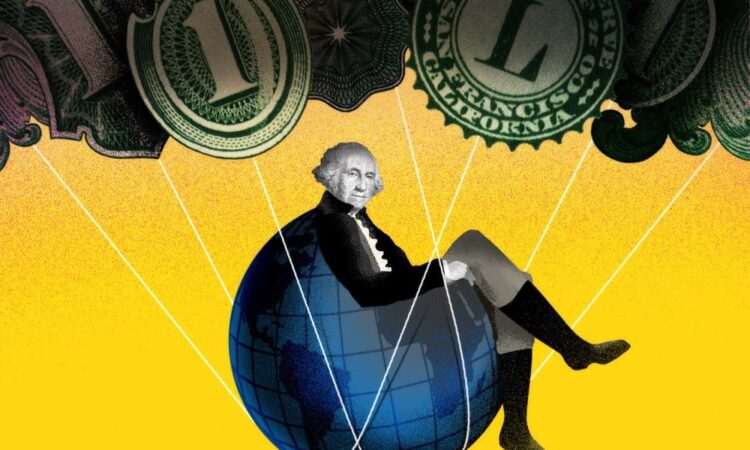
It has been 80 years since the Bretton Woods Conference, when the U.S. dollar became the central pillar of the world economy and of U.S. economic statecraft. And for eight decades, we’ve also witnessed predictions about the dollar’s coming demise. But almost from the beginning, the debate about the future of the dollar has missed the mark. The question isn’t about whether an event or a crisis or a new technology will knock the dollar off its pedestal. Rather, it is about how the United States’ competitors, and even partners, are pushing the boundaries of the financial system in a global economy where the dollar still dominates but the post-Cold War consensus is breaking down.
For decades, any number of events reportedly portended the end of the dollar. When U.S. President Richard Nixon delinked the dollar from gold in 1971, a prominent British journalist declared it the “moment of the formal dethronement of the Almighty Dollar.” Some saw the euro’s introduction in the 1990s as the moment for the dollar’s demise. The global financial crisis and the rise of China in the 2010s led many economists to predict that the yuan could become the world’s reserve currency. Finally, Russia’s full-scale invasion of Ukraine in 2022 and Western-led sanctions against Moscow raised questions about a coming “post-dollar world.”
There are real geoeconomic headwinds to the dollar. Countries are working to become less reliant on the dollar for trade and to distance themselves from U.S. payment systems. But the future isn’t a binary between dollar dominance and so-called de-dollarization. The U.S. economy remains the world’s largest, with the deepest capital markets and most trusted financial institutions. The dollar remains a financial safe haven and the most reliable medium of exchange and store of value, not just for the United States but globally. The networks and history that earned the dollar its position eight decades ago are holding, and the growing frustration with the dominance of the dollar obfuscates some of the conveniences as well. What has changed is that the United States’ competitors—and some partners—are pushing the limits of their financial autonomy within the dollar-based system, emboldened by technological advances and geoeconomic revisionism. But we are far from an inflection point where we see any concerted effort to actually change it.
If the dollar’s position were to change, it would come from evolution, not revolution. More countries will test and deploy measures to limit the dollar’s reach. Emerging financial technologies will catalyze new theories of change and a range of multilateral financial arrangements. Meanwhile, Western policymakers and business leaders will have to protect the dollar’s historic position even as the U.S. economy takes on larger amounts of debt in a less stable world. But the dollar will continue to underpin the global economy for the foreseeable future.
- A U.S. Treasury worker lays sheets on the engraved plates of a printing press, circa 1935. Keystone/Getty Images Archive
- Bars of gold are weighed and earmarked for international exchange transactions in the vaults of the New York Federal Reserve Bank, circa 1965. Alan Band/Keystone/Getty Images
There has never been a currency quite like the U.S. dollar. Historians analogize to the Spanish Empire’s pieces of eight, Dutch guilders, or the U.K. pound sterling, which was the leading reserve currency until the 1920s. But, as economist Michael Pettis points out, the dollar is “the only currency ever to have played such a pivotal role in international commerce.” The dollar accounts for 58 percent of foreign reserve holdings worldwide. It is involved in 88 percent of all foreign exchange transactions. Due to its international footprint, other countries’ trade imbalances are offset by imbalances in the United States.
The dollar provides stability and safety to countries and consumers globally, not just to the United States. It is a trusted asset because of the United States’ open markets, rule of law, trusted institutions, and deep, liquid capital markets. Beyond the United States, there is a limited supply of investment-grade assets. But the dollar isn’t without its discontents. In the last few years, a growing number of world leaders have publicly stated that they intend to knock the dollar off its pedestal. They see a divided world, the rise of financial technologies that increase the efficiency of trading with currencies other than the dollar, and a divided United States with an uncertain fiscal position and an ever-increasing list of countries and entities with which it is in economic confrontation—and they are publicly positioning themselves to take advantage.
In a world with more conflict and competition, talk of de-dollarization will continue. Were the U.S. dollar not central to the global economy, adversaries could better evade sanctions, and there could be more potent alternative economic blocs. That’s why, during a speech in Shanghai last year, Brazilian President Luiz Inácio Lula da Silva stated dramatically, “Every night I ask myself why all countries have to base their trade on the dollar.” Warning of the dangers of U.S. “institutional hegemony,” China’s Ministry of Foreign Affairs released an essay in February 2023 arguing that through the dollar, Washington “coerces other countries into serving America’s political and economic strategy.” Going further, the ministry stated that the “hegemony of [the] U.S. dollar is the main source of instability and uncertainty in the world economy.”
A woman walks past a currency exchange office in central Moscow on Feb. 24, 2022, the day Russia launched its full-scale invasion of Ukraine.Alexander Nemenov/AFP via Getty Images
The timing of such pronouncements—roughly one year after Russia’s full-scale invasion of Ukraine and the subsequent imposition of sanctions—belies the true motivations behind them. The nearly eight decades of dollar dominance have witnessed some of the greatest peace and prosperity in history, including the rise of countries such as China. The dollar was not imposed on the world in 1944; it emerged out of postwar circumstances and a remarkable degree of international consensus, when 44 countries, including China and Brazil, assembled in Bretton Woods to determine the post-World War II financial order. What’s driving instability today is not the dollar but war in Europe and the Middle East, as well as tensions in the Indo-Pacific. These geopolitical challenges are connected, including through the deepening support that China provides to Russia. As Moscow has used that economic lifetime to sustain its assault on Ukraine, the war has changed how money moves around the world. Within weeks of Russia’s invasion, a U.S.-led coalition of 37 allies and partners, representing more than 60 percent of the world economy, imposed sanctions and export controls on Moscow. By April 2022, the value of Russian imports had fallen to around 43 percent below the prewar median. The results have been more severe than the Kremlin lets on, and ordinary Russians are feeling the pain the regime has caused. But a pivot to Asia saved Moscow, as Russia found new markets and means to put its economy on a war footing. The country now spends 6 percent of its GDP on its military.
What has changed isn’t only where the money has come from but what that money looks like. We see this in the former Soviet republics in Central Asia and the Caucasus, which purchase Western technology in dollars and sell it to Russia for rubles. We see it with Russia’s trade with China—in the first nine months after its full-scale invasion of Ukraine, Russia’s ruble-yuan trade jumped more than 40 percent. Meanwhile, China’s two-way trade with Russia hit a record high of $240 billion in 2023, up 26.3 percent in just one year. The yuan recently displaced the dollar as the most traded currency in Russia, accounting for nearly 42 percent of all foreign currency traded on the Moscow Exchange. As a result, the war and Moscow’s evasion of U.S. payment systems have led the largest country and second-largest economy in the world to trade mostly in currencies other than the dollar.
Internationalization of a currency other than the dollar is still a long way off, however. The continued dominance of the U.S. dollar is a vote of confidence from millions of market participants ranging from governments to corporations to households. It would take not just bilateral changes but new and trusted institutions and multilateral alignments based on the rule of law, transparency, and accountability to create any plausible alternative. While the Chinese-led Cross-Border Interbank Payment System (CIPS) is one such attempt, and it handles a reported 25,900 a day, that total falls significantly short of the U.S. Clearing House Interbank Payments System, which does approximately 500,000 daily transactions totaling $1.8 trillion in value. And of the CIPS transactions, 80 percent rely on SWIFT, a system based in Belgium, not Beijing. The trust the dollar has earned in the last eight decades sets it apart.
A woman walks out of a currency exchange shop in Cairo on Aug. 24, 2022. Khaled Desouki/AFP via Getty Images
The two most significant problems for those advocating wholesale de-dollarization are that it is impossible to replace something with nothing and the United States’ competitors do not currently have the capability or will to replace the dollar, even if their rhetoric at times suggests otherwise. That doesn’t mean the dollar’s position should be taken for granted. Innovation and geoeconomic fragmentation may chip away at its reach. The most important emerging trends are new technological models, sector-specific arrangements, and bilateral and multilateral alignments. These efforts are marginal, but they may provide meaningful alternatives in the future.
The United States has financial technologies that are as developed as most leading markets, but it lags a small number of countries in consumer adoption of certain financial technologies. These comparisons run the gamut. In 2021, El Salvador became the first country to make cryptocurrency legal tender. More importantly, the Atlantic Council tracks the proliferation of central bank digital currencies, or CBDCs, and reports that 134 countries and currencies unions, representing 98 percent of the world’s GDP, are exploring use cases for CBDCs, up from just 35 in 2020. Pilot projects are underway in 11 of the G-20 member states, though only three countries have fully launched a CBDC. In a more divided world, there are more CBDCs—since February 2022, according to the Atlantic Council, “wholesale CBDC developments have doubled.”
When U.S. consumers mass adopted financial technologies such as credit credits in the 1970s and ’80s, China’s economy was in relative shambles, and it was still recovering from the Cultural Revolution. Its GDP was just $154 billion in 1976. Today, however, China is the second-largest economy in the world, and its digital yuan, or e-CNY, has drawn the focus of many experts who talk about technology-led efforts toward “de-dollarization.” The e-CNY could provide greater efficiencies and financial inclusion to unbanked Chinese citizens, but in many ways, there are few differences between it and digital and mobile payment systems in the West.
Nevertheless, China is making efforts to internationalize the e-CNY as a dollar alternative, and the Chinese government made that intention clear with its choice of venue for the digital currency’s debut: the 2022 Beijing Olympics. During the games, visitors to the capital city, still under strict COVID-19 restrictions, went through customs and were immediately able to exchange currency for e-CNY. Rather than increasing trust abroad, however, this not only raised concerns about Beijing’s leadership in financial technology; it also set off alarms about how that technology could be used to increase the Chinese Communist Party’s control over Chinese society and potentially create new forms of geoeconomic leverage that China could use over the rest of the world.
Visitors pay using China’s digital currency e-CNY during the 2023 China International Fair for Trade in Services in Beijing on Sept. 2, 2023.Tian Yuhao/VCG via Getty Images
The fact that it has not had any significant uptake in other countries indicates that the e-CNY is not a trusted alternative abroad, and it is still in the pilot stages, even at home, where it reaches 260 million wallets in just 25 Chinese cities out of a population of more than 1.4 billion. But the push to internationalize China’s digital currency is ongoing. Project mBridge—a cross-border CBDC program involving mainland China, Hong Kong, Thailand, and the United Arab Emirates, as well as 25 observer nations—is one such effort. There is international interest in more efficient, low-cost alternatives to payment rails that rely on the dollar, even if the Chinese government were not already taking steps to increase trust in the e-CNY in much of the world.
However, China is finding new avenues for limited de-dollarization with its closest partners. China is now the top trading partner of more than 120 countries, particularly in East Asia, sub-Saharan Africa, and emerging, resource-rich markets. With a greater global economic footprint, China is working to shift the balance of payments away from the dollar, and as much as 23 percent of China’s total goods trade is now in yuan.
We see that trend most clearly in the oil trade. Oil is priced in dollars, and the trade volume in the global oil derivatives market—approximately 23 times the size of average daily physical crude flows—is fully denominated in dollars. But Beijing is working to reduce the dollar’s role in its own trade and in the global economy. China is a large, but resource-poor, country that relies on energy imports, mostly from the Middle East. As of last year, China imported around 1.8 million barrels of oil from Saudi Arabia a day. In an effort to insulate that trade from the dollar, Riyadh and Beijing have signed a $7 billion currency swap agreement. And with around 14 percent of daily global crude oil volume flows coming from sanctioned states, the incentives to de-dollarize in this sector are clear.
Here, however, the reach of those who seek to de-dollarize the oil markets may have exceeded their grasp, as shown by trade patterns between India and Russia. Following the imposition of Western-led sanctions on Russia, India became a top destination for Russian seaborne crude oil, hitting 2.15 million barrels a day in May 2023. But New Delhi insisted on the use of Indian rupees for conversion and settlement. That position, coupled with sanctions and embargoes on Moscow, has since caused friction. Despite the initial uptick, oil trade between Russia and India recently hit a 12-month low.
Workers stack oil barrels at a filling station in Chennai, India, on Feb. 24, 2022. Arun Sankar/AFP via Getty Images
Moves to “sanctions-proof” whole economies take many other forms. For years, Moscow has been steadily decreasing its dollar holdings, with its stockpile of U.S. Treasurys declining from $102.2 billion in December 2017 to a mere $14.9 billion six months later. Similarly, in 2023, China decreased its own holdings of U.S. Treasurys and upped its gold purchases by 30 percent. These trends aren’t limited to U.S. adversaries and competitors—as Goldman Sachs Research has noted, India, which had been the subject of U.S. sanctions over its nuclear program until the George W. Bush administration, has also upped its own gold holdings, though gold remains a small percentage of its reserve holdings globally.
Gold provides a degree of diversification and insulation from sanctions, but it’s not an alternative for the dollar. The real returns are much less predictable, gold comes with significant carrying and storage costs, and gold’s functionality as a medium of exchange for trade settlement is low. Meanwhile, physical gold supply is limited, with gold futures backed by around just $40 billion worth of the precious metal. That number climbs higher with the inclusion of exchange-traded funds, which create opportunities for diversification and investments in many assets, but it still is far short of international currency markets.
Technology could change the uses and role of gold in the global financial system as well. Historically, gold has often proved a better store of value than fiat currency. But it lacks the same functionality, not to mention greater storage and movement costs. The digitization of physical gold in the existing vaulting system, however, can afford it greater efficiency functionality of settlement.
Whatever technological progress, true de-dollarization would take a compelling alternative backed by multilateral consensus. China-led groupings such as the Shanghai Cooperation Organisation, the Belt and Road Initiative, and BRICS (now BRICS+) are, in their own ways, attempting to create such a forum. That’s why Brazil’s president called on the BRICS countries to create a common currency at last year’s summit in South Africa, arguing to his fellow leaders that such a medium of exchange “increases our payment options and reduces our vulnerabilities.”
Even this widely publicized effort has pitfalls. The original BRICS countries are home to 42 percent of the world’s population and, according to the International Monetary Fund, a third of the world’s economic output. But economic, ideological, and geopolitical differences make any united policy outcomes exceedingly unlikely. Even members dismiss the notion of BRICS-led de-dollarization, with Indian Foreign Minister S. Jaishankar stating last July, “There is no idea of a BRICS currency.”
The data underscores Jaishankar’s sentiments. According to the Bank for International Settlements, the U.S. dollar is the backbone of the BRICS trade. In 2022, it was involved in 97 percent of all foreign exchange transactions involving the Indian rupee, 95 percent of all such transactions involving the Brazilian real, and 84 percent of all such transactions involving the yuan.
While efforts to move away from the dollar have, in some sectors, gained traction, the rhetoric around de-dollarization is, in many ways, more about performative politics than serious policy. To make the yuan more attractive, Beijing could loosen its capital controls or move away from a surveillance state model, but it shows little signs of doing do. The European Union could boost the euro if it were to create the kinds of capital markets that drive the U.S. financial system, but it hasn’t. These moves would be beneficial to Chinese citizens and Europeans alike. But for now, the dollar remains the most trusted, and in many ways most efficient, currency for not only the United States but most of the world. And while BRICS may have the desire to build a new international financial system, the global economy that has allowed the emerging markets to emerge over the last 25 years was built on the dollar.
Brian Stauffer illustration for Foreign Policy
The United States’ rivals may not succeed in pulling the world away from the dollar, but Washington should be careful not to push the rest of the world out of its orbit either. The use of the dollar for sanctions can be a valuable tool of economic statecraft, and sanctions have been deployed by Western governments since 432 B.C., when Athens put an embargo on the nearby town of Megara in the lead-up to the Peloponnesian War. When they are overused or abused, however, they erode trust and leave the rest of the world seeking to protect itself from a weaponized global economy.
The debate about the use of sanctions has gotten more urgent and taken new forms in the last two years. Soon after Russia’s invasion of Ukraine, the United States and its allies froze around $300 billion worth of sovereign Russian assets in the West. That included a substantial portion of Russia’s gold and foreign currency reserves, denominated in euros, dollars, British pounds, Japanese yen, and other currencies. While the global economy adapted to these sanctions for two years, we recently entered a new chapter in financial history.
Before this year, the United States had never seized the foreign assets of a country with which it was not at war. However, on April 24, President Joe Biden signed the Rebuilding Economic Prosperity and Opportunity (REPO) for Ukrainians Act, establishing a means to do just that and seize Russian assets to support Ukraine.
The case for REPO was clear and compelling, at least to Washington and most of its partners. With each passing day, the cost to rebuild Ukraine grows: The World Economic Forum puts the figure at around $486 billion. Repurposing Russian assets is a politically elegant solution that has the benefit of imposing no direct costs to U.S. or EU taxpayers. But like most policies, it involves trade-offs, and it was the subject of considerable debate at the recent G-7 finance ministers meeting in May.
What might this policy change lead to? The American Enterprise Institute’s Michael Strain observed that critics argue that the seizure of Russian assets could make other countries worry that their own assets might one day be seized. Given that risk, they’d take preventative steps to distance themselves from Western economies, making them less willing to hold dollars or euros or even invest in the West. Strain finds these risks to be “legitimate, but ultimately unpersuasive” when it comes to REPO, but they should not be dismissed, including when working with allies whose involvement would be required to make such measures effective.
These conversations show how the actual or perceived overuse of economic coercion will likely only increase other countries’ desires to find alternatives to the U.S. dollar. Sanctions are most effective when they are targeted, multilateral, and set out to achieve specific objectives. Used prudently, they enhance the United States’ economic position, but when they are abused, they leave the country weaker.
U.S. Treasury Secretary Henry Morgenthau and Chinese Vice Premier H.H. Kung attend the Bretton Woods Conference in 1944. Universal History Archive/via Getty Images
The dollar’s demise has been overpredicted for decades. Those who think the dollar will reign supreme forever, though, should take a lesson in humility from Charles Krauthammer. In January 1990, with the United States at the height of its power at the end of the Cold War, he wrote that the “most striking feature of the post-Cold War world is its unipolarity. No doubt, multipolarity will come in time.” The dollar’s unipolar moment isn’t over. But the world could change.
When the dollar emerged as the consensus of the post-World War II world, the U.S. economy accounted for perhaps half of global GDP. Since then, China became the world’s second-largest economy. Beijing is challenging the U.S.-led order. Emerging markets have developed and are seeking greater autonomy. New currencies and technologies have come online. Meanwhile, Washington doesn’t always safeguard the privilege that the dollar bestows. Unnecessary tariffs can diminish the United States’ role and reach in the global economy. Fiscal brinksmanship, combined with repeated confrontations over the debt limit and even the threat of default, erode confidence; the U.S. national debt is approaching $35 trillion, and budget deficits are expanding at record rates, even during peacetime.
If the dollar’s detractors truly seek an alternative, however, they would be forced to adopt radically different policies. The economic troubles that China is experiencing today appear to be more structural than cyclical. Beijing’s closed capital account restricts the amount of yuan available to transact, and last year, China reported its first-ever quarterly deficit in foreign direct investment. While many of China’s trading partners share the desire to move away from the dollar, Goldman Sachs Research has noted that even they have limits on how much yuan they can accumulate, as their own currencies are often pegged to the dollar. When it comes to the United States’ allies, even the EU has not taken steps to create deep, liquid capital markets that could increase the euro’s appeal as an alternative.
The move toward de-dollarization remains marginal but meaningful and moving. For the dollar to lose its place, it would take a series of policy failures in Washington and for the dollar’s detractors to create alternatives that have appeal not only in authoritarian, state-led economies but globally. The global financial system is changing, and nothing is certain. But it would still be wrong to bet against the dollar.











